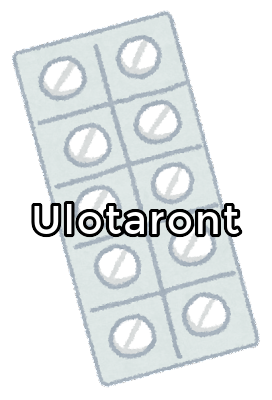- Introduction
- Clinical Trial Data (Mean score reduction, Difference from Placebo)
- The “Mean score reduction” of Ulotaront is not small.
- The “Mean score reduction” of the placebo is too large.
- Reason for the very large “Mean score reduction” of the placebo
- Summary
- What’s Next for the Development of Ulotaront?
- Comment
- References
Introduction
The results of the Phase 3 trials of Ulotaront were released in July 2023. Two Phase 3 trials were both failures.
In this article, I consider the Phase 3 trial results data. I will also consider the next step of Ulotaront development.
Clinical Trial Data (Mean score reduction, Difference from Placebo)
Two Phase 3 trials, DIAMOND 1 and DIAMOND 2, were conducted. The only published outcome data are the “Mean score reduction” in PANSS for the investigational new drug and placebo drug. They are shown in the table below.
| 6 weeks | Mean score reduction (Ulotaront) | Mean score reduction (placebo) | Difference from Placebo |
| DIAMOND1 | -19.6 (75 mg) | -19.3 | -0.3 |
| DIAMOND2 | -18.1 (100 mg) | -14.3 | -3.8 |
For more information on PANSS score, see this article.
Positive and Negative Syndrome Scale(PANSS, Scale used to measure efficacy)
The larger the mean reduction in PANSS score, the greater the improvement in schizophrenia symptoms. The larger the score reduction, the more effective the drug is.
In clinical trials, the “Mean score reduction” in PANSS of a placebo drug is also measured.
The difference between the “Mean score reduction” of the investigational new drug and the placebo drug is then calculated.
This difference is called the “Difference from Placebo“. For a clinical trial to be successful, this “Difference from Placebo” must be large enough.
Both the “Mean score reduction” of the investigational new drug and the “Difference from placebo” can be used as a measure of efficacy, but the “Difference from placebo” is higher as evidence of efficacy.

In this article, I consider the “Mean score reduction” in PANSS that has been published as the efficacy of Ulotaront, in addition to the “Difference from placebo“.
The “Mean score reduction” of Ulotaront is not small.
First, I would like to take a look at the “Mean score reduction” of the investigational new drug.
| 6 weeks | Mean score reduction (Ulotaront) | Mean score reduction (placebo) | Difference from Placebo |
| DIAMOND1 | -19.6 (75 mg) | -19.3 | -0.3 |
| DIAMOND2 | -18.1 (100 mg) | -14.3 | -3.8 |
If we look again at the table above, we see that the “Mean score reduction” for the investigational new drug Ulotaront is -19.6 and -18.1.
Six weeks of treatment with Ulotaront improved PANSS scores by an average of -19.6 or -18.1 points.
These figures are not inferior to those of other antipsychotic drugs in successful trials. The “Mean score reduction” in other antipsychotic trials, to the best of my knowledge, is shown in the table below.
| Study drug | Dosing period | Phase | Mean score reduction |
| Ulotaront | 6weeks | Phase3① | -19.6 |
| Ulotaront | 6weeks | Phase3② | -18.1 |
| Ulotaront | 4weeks | Phase2 | -17.2 |
| Lumateperone | 4weeks | Phase3 | -14.5 |
| Lurasidone | 6weeks | Phase3① | -17.9 |
| Lurasidone | 6weeks | Phase3② | -19.3 |
| Emraclidine | 6weeks | Phase1b | -19.5 |
| KarXT | 5weeks | Phase3① | -21.2 |
| KarXT | 5weeks | Phase3② | -20.6 |
Looking at the table above, when the placebo effect is not considered, the efficacy of Ulotaront appears to be no different from that of the other drugs.
It is slightly smaller than KarXT, but comparable to Emraclidine and Lurasidone. It seems the improvement of Ulotaront is greater than that of lumateperone.

The “Mean score reduction” for Ulotaront is comparable to other drugs that had successful trials.
As far as the “Mean score reduction” is concerned, the efficacy of Ulotaront is sufficient.
The “Mean score reduction” of the placebo is too large.
Next, let’s look at the “Difference from placebo” as a measure of efficacy. The “Mean score reduction” and the “Difference from placebo” for the two studies are again shown in the table below.
| 6 weeks | Mean score reduction (Ulotaront) | Mean score reduction (placebo) | Difference from Placebo |
| DIAMOND1 | -19.6 (75 mg) | -19.3 | -0.3 |
| DIAMOND2 | -18.1 (100 mg) | -14.3 | -3.8 |
In the phase 3 studies, the “Mean score reduction” for the placebo is -19.3 and -14.3, which is quite large (negative range). The improvement in schizophrenia symptoms with placebo administration was quite large.
Because of this, the “Difference from placebo,” which is a measure of efficacy, was smaller at -0.3 and -3.8.
In other words, the improvement in symptoms with the placebo was so large that it mask the improvement with Ulotaront.
In general, “Mean score reduction” for placebo in antipsychotic trials is usually around -10 points (depending on the duration of treatment).
The -19.3 in the DIAMOND 1 trial and the -14.3 in the DIAMOND 2 trial for the placebo may be quite large. Nothing we have seen so far has been this large.
Incidentally, during the Phase 2 trial of Ulotaront, the “Mean score reduction” for the placebo was -9.7.

In the phase 3 trials, the “Mean score reduction” for the placebo was too large. Because of this, the “Difference from placebo” was smaller and the trials failed.
The improvement in schizophrenia symptoms with the placebo was so large that they masked the improvement in symptoms with Ulotaront.
Reason for the very large “Mean score reduction” of the placebo
In the Ulotaront trials, it is believed that COVID-19 caused the “Mean score reduction” for the placebo to be too large.
Within the clinical trial period, there is variability in when subjects were given drugs. Some patients received a drug before COVID-19, while others received a drug after COVID-19.
When the trial data were analyzed, it appears that Ulotaront tended to show significant efficacy when looking only at patients who received the drug before COVID-19.

Apparently one of the reasons for the large “Mean score reduction” for the placebo was the “impact of COVID-19”. Without COVID-19, the trials might have been successful.
Summary
- The Phase 3 trials of Ulotaront failed because the improvement in placebo scores was too large.
- The large improvement in the placebo scores was due to COVID-19.
- If the placebo effect is not included in the calculation, the efficacy of Ulotaront was sufficient.
What’s Next for the Development of Ulotaront?
So, with further analysis of the clinical trial data, it might be possible to argue that Ulotaront is effective.
Sumitomo Pharma is planning to hold meetings with the FDA (U.S. Food and Drug Administration) in order to launch the product in the future.
What I write below may be incorrect due to the lack of research, but I believe that the meetings with the FDA will probably go as follows.
First, the FDA will ask Sumitomo Pharma as follows, “Can you prove that Ulotaront is really effective, even though Phase 3 trials failed to show efficacy?
The proof should be based on the existing clinical trial data. If the efficacy can be proven, the FDA will accept the application for marketing approval.
If the existing data are not sufficient to prove the efficacy, the FDA may require an additional clinical trial.
If an additional trial is conducted, the launch may be delayed by that amount. The trial may fail again. Or, they might not do the additional trial and stop development.
Opinions on X (Twitter) and news articles suggested that the FDA would accept the application and even approve it based on existing data alone. In other words, Ulotaront may be successfully launched without too much delay.
The Phase 2 trial was successful, so even if the Phase 3 trials did not show efficacy in a complete form, they might be OK.
However, based on discussions with the FDA, they are planning to revise the target launch date of 2024.

The U.S. Phase 3 trials failed. However, there are some speculations that the U.S. launch of Ulotaront will not be eliminated, even if there may be a delay.
I will continue to follow the information to see if Ulotaront will really be launched in the U.S. and how the meetings with the FDA will turn out.
Comment
When I heard that the Phase 3 trials of Ulotaront were not successful, I was quite disappointed.
However, it seems that development will not be halted, and there is still hope.
A long-term study is currently underway, and I hope that it will show positive results.
Click here to read the related articles.
Innovative Schizophrenia Drugs【Summary part 2】Ulotaront, etc.
New Antipsychotics 3: Ulotaront Part1(Side Effects, Phase, TAAR1)
New Antipsychotics 3: Ulotaront Part2(Phase2 efficacy data)
A lot of benefits of taking Ulotaront: A new antipsychotic drug
[democracy id=”86″]